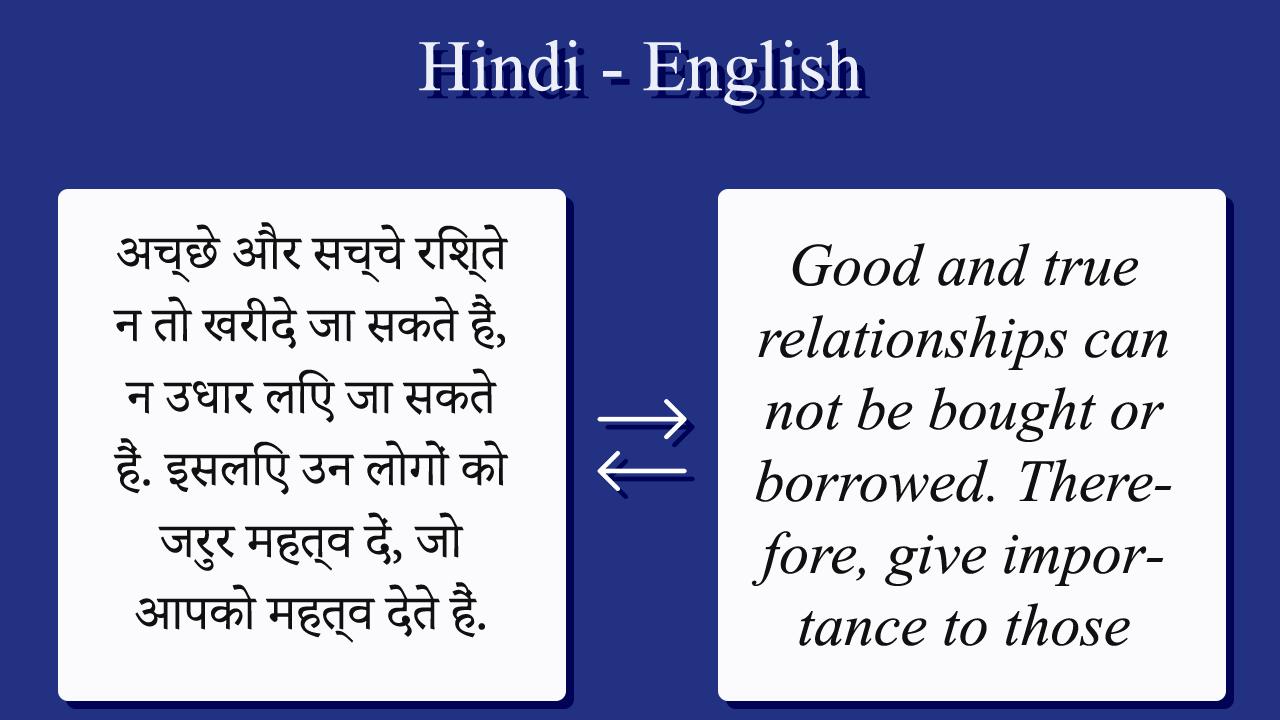Introduction:
In the tapestry of India’s linguistic diversity, Hindi and English translation emerge as powerful tools that transcend language barriers, fostering cultural exchange, facilitating global communication, and contributing to the preservation of heritage. This exploration delves into the myriad features and far-reaching benefits of effective translation between Hindi and English.
1. Cultural Exchange and Understanding: Feature: Translation bridges cultural gaps by making literary, artistic, and historical works accessible in both Hindi and English. Benefit: It cultivates a deeper understanding and appreciation of diverse cultures, promoting a sense of shared humanity.
2. Global Communication: Feature: English as a global lingua franca enables international communication, and translation broadens the reach of content to a global audience. Benefit: Businesses, organizations, and individuals can engage on a global scale, fostering cross-cultural collaboration and understanding.
3. Preservation of Heritage: Feature: Hindi and English translation preserves the rich cultural heritage of India, ensuring that traditional stories, folklore, and historical texts are passed down through generations. Benefit: It connects individuals with their roots, fostering a sense of cultural identity and continuity.
4. Educational Accessibility: Feature: Bilingualism in educational materials ensures equal access to knowledge in Hindi and English, preparing students for a globalized world. Benefit: An inclusive education system empowers students, irrespective of linguistic backgrounds, promoting academic excellence and career opportunities.
5. Business Expansion: Feature: Translating business content facilitates market expansion, allowing companies to connect with a broader audience. Benefit: Increased market presence, customer engagement, and brand visibility contribute to business growth in diverse linguistic regions.
6. Effective Communication in Government: Feature: Translation in government documents promotes citizen understanding of policies and laws in both Hindi and English. Benefit: Transparent communication reduces language-related barriers, fostering civic participation and trust in the government.
7. Diplomatic Relations: Feature: Accurate translation is crucial for effective communication between nations in diplomatic contexts. Benefit: It enhances international cooperation, understanding, and positive relations, contributing to successful diplomacy.
8. Career Opportunities: Feature: Proficiency in Hindi and English, coupled with translation skills, unlocks diverse career opportunities in various fields. Benefit: Bilingual individuals are highly sought after in the job market, enhancing employability and career advancement.
9. Community Building: Feature: Translation fosters community building by enabling effective communication among individuals from different linguistic backgrounds. Benefit: Stronger communities promote social cohesion, mutual understanding, and shared values, contributing to a harmonious society.
10. Accessibility in Media and Entertainment: Feature: Subtitling, dubbing, and translation in the entertainment industry ensure content accessibility across linguistic boundaries. Benefit: It enriches the entertainment experience, promoting cross-cultural appreciation and allowing diverse audiences to enjoy content from different regions.
11. Literary Enrichment: Feature: Translation opens doors to literary enrichment by bringing the works of renowned authors, poets, and thinkers into the realm of both Hindi and English readers. Benefit: Readers gain access to a diverse literary landscape, fostering intellectual growth, and expanding perspectives.
12. Technological Advancements in Translation: Feature: The integration of technology, including machine translation and AI, has revolutionized the translation process, making it more efficient and accessible. Benefit: Technology accelerates translation workflows, reduces costs, and enhances overall translation accuracy, especially for large-scale projects.
13. Scientific and Technical Collaboration: Feature: Translation is instrumental in facilitating collaboration in scientific and technical fields by ensuring that research findings, technical documentation, and innovations are accessible in both Hindi and English. Benefit: It promotes knowledge exchange, accelerates advancements, and fosters international cooperation in research and development.
14. Social Media and Online Engagement: Feature: Social media platforms and online spaces utilize translation features to connect people from diverse linguistic backgrounds. Benefit: Users can engage with content, discussions, and social movements across language barriers, fostering a global online community.
15. Legal Clarity and Justice: Feature: Legal documents and court proceedings benefit from accurate translation to ensure that justice is accessible to all citizens, regardless of their language proficiency. Benefit: Translation in legal contexts reduces the risk of misunderstandings, promotes fair trials, and upholds the principles of a just legal system.
16. Multilingual Marketing Strategies: Feature: Businesses employ multilingual marketing strategies through translation to tailor their messages to specific cultural contexts and consumer preferences. Benefit: Targeted marketing enhances customer engagement, builds brand loyalty, and facilitates successful market penetration in diverse regions.
17. Tourism and Cultural Exchange: Feature: Translation plays a pivotal role in the tourism industry by providing information about destinations, cultural practices, and historical sites in both Hindi and English. Benefit: It encourages tourism, promotes cross-cultural interactions, and enriches the travel experience for visitors from different linguistic backgrounds.

18. Language Preservation: Feature: In the face of language endangerment, translation contributes to language preservation efforts by documenting, translating, and revitalizing endangered languages. Benefit: It ensures the survival of linguistic diversity, preserving unique cultural expressions and oral traditions for future generations.
19. Crisis Communication: Feature: During crises such as natural disasters or health emergencies, translation facilitates effective communication of critical information to affected communities in their native languages. Benefit: Timely and accurate communication aids in crisis management, reduces risks, and ensures the safety and well-being of diverse populations.
20. Personal Enrichment and Lifelong Learning: Feature: Individuals can enhance their personal growth and knowledge by exploring content in both Hindi and English through translation. Benefit: Lifelong learning becomes more accessible, allowing individuals to pursue interests, hobbies, and educational opportunities beyond linguistic boundaries.
Conclusion:
In essence, the features and benefits of Hindi and English translation weave a narrative of interconnectedness and harmony. From preserving cultural heritage to facilitating global business endeavors, effective translation acts as a catalyst for understanding, collaboration, and shared progress. As we navigate a world shaped by linguistic diversity, the strategic use of translation emerges not merely as a linguistic exercise but as a transformative force that bridges gaps, connects hearts, and enriches the global tapestry of human experience.

